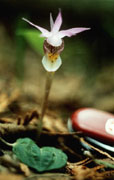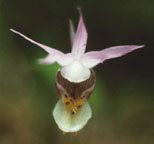Calypso bulbosa (L.) Oakes
Calypso, fairy slipper
This monotypic genus is palearctic in distribution, and extends south to
Arizona in the mountains of the western United States. The genus Calypso
is named for the beautiful nymph in Homer's Odyssey who waylaid Ulysses
on his return to Ithaca. The specific epithet bulbosa is the Latin
meaning "bulbed," in reference to the small pseudobulb of this
species.


Photos courtesy of Emmet Judziewicz
DESCRIPTION: Plant arising
from a bulbous corm. Leaf ovate, solitary, basal, 2-6 cm long and
2-4.5 cm wide. The leaf arises in late summer and persists through winter,
withering after the plant flowers. Flower solitary, pendent, terminating
an 6-21 cm tall stem. Sepals lanceolate to lance-linear, 1-2 cm long
and 2.5-5 mm wide, purplish-pink to purplish-white, rarely white. Petals
similar to sepals, sepals and petals spreading above the labellum. Labellum
saccate, oblong (often described as "slipper-shaped"), 1.5-2.5
cm long and 6-11 mm wide, with two small projections at the apex and an
"apron" of tissue extending from the opening. Labellum whitish-pink,
liberally streaked with madder purple, spotted with the same near the opening.
The "apron" has a brush of yellow hairs near the opening to the
labellum, and the projections of the labellum are often yellowish as
well. The column is petaloid and overhangs the opening to the labellum.
SIMILAR SPECIES: I can think of no other orchid that could be confused
with Calypso, although some may see resemblance to species of Cypripedium.
HABITAT: Almost entirely restricted to Thuja bogs in the northernmost
parts of the state, where it grows on dry hummocks of organic material.
It may also be found in dry Thuja-Pinus-Abies woods over limestone/dolomite
along the Lake Michigan Lake Superior shores. It seems to need cool soils.
FLOWERING DATES: May 20-June 25.
POLLINATION: Calypso is pollinated by a number of species of
bumblebees (Mosquin 1970, Boyden
1982). Like several other orchids in Wisconsin, it has a deceptive pollination
system. The bumblebees are deceived by the yellow bristles, but upon visiting
the flower, find no nectar or pollen reward.
DISCUSSION: This species is very rare in Wisconsin, and appears to
have declined since Fuller (1933).
Indeed, throughout the southern part its eastern range, Calypso has
been in decline for the last 30 years or so. Given the preference of this
orchid for cool soils, some feel its decline is an early indicator of global
warming.
WI DISTRIBUTION:  U.S. DISTRIBUTION:
U.S. DISTRIBUTION:
Go directly to Wisconsin herbarium records.
Return
to the main LIST of the Orchids of Wisconsin.
Return to the main KEY to the Orchids of
Wisconsin.


 U.S. DISTRIBUTION:
U.S. DISTRIBUTION: